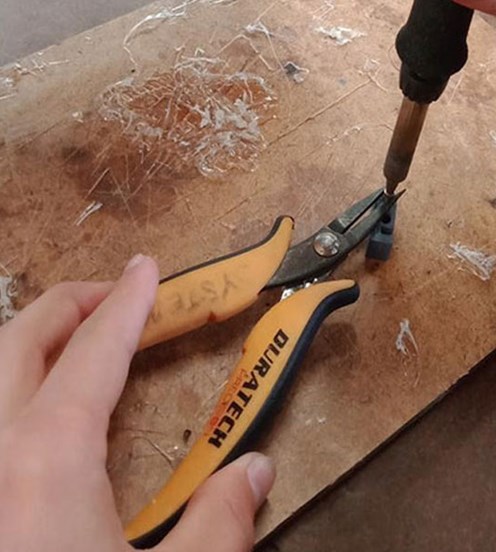
Systems Engineering folios
Examples of outstanding folio pages relating to the study criteria.
Mechanical and electrotechnological systems used in homes and industry have significant effects on society and the environment. VCE Systems Engineering applies innovative thinking and problem-solving skills to technologies in ways that transform people’s lives.
Students design, construct and assemble an integrated and controlled aspect of an operational system, using mechanical and electrotechnological components. They create a solution for a system-based problem, need, opportunity or situation by applying technological, mathematical and scientific principles. Production activities are planned and recorded, and then testing and evaluation occurs. Systems on display reflect creative thinking and technical skills.
Padua College, Mornington
Bunurong Country
Laser cut acrylic frame, 3D printed PLA plastic dish and brackets, light-dependent resistors, stepper motor and driver, micro servos, Arduino Uno microcontroller, custom-made CNC circuit board
To maximise heating efficiency, I have built a system that concentrates solar heat toward a focal point to heat mass. I intended to run a pipe over the mirror, to reflect the sun and heat water before entering the gas heater. As a result, this would lower my gas bills and greenhouse emissions. I used light dependent resistors to detect the sun, together with an Arduino to control micro servos and a stepper motor for the tracking and movement system. I incorporated these components together with laser cut acrylic and 3D printed brackets.
Girton Grammar School, Bendigo
Dja Dja Wurrung Country
Laser cut acrylic and MDF panels, 3D printed rack and pinion, Arduino Uno, stepper motor, HR sensor, stepper motor driver, LCD display, emergency button, Ambu bag, custom PCB
I have designed an integrated system to automate the provision of ventilation, which would otherwise be issued through handheld Ambu bag compression by healthcare workers. The automation of this intensive procedure decreases worker fatigue, and the low cost allows for provision in developing countries. The Arduino (control center) utilises user set inputs (tidal volume and Breaths Per Minute) along with an algorithm to determine the frequency of the pulses sent to the stepper motor. The motor drives a rack and pinion to compress the Ambu bag.
Viewbank College, Viewbank
Wurundjeri Country
PLA, MDF, Raspberry Pi Pico, SG90 servo motors, OLED display, rotary encoder, LEDs, recycled 3mm acrylic sheet
I have developed a controlled electromechanical system that automatically sorts resistors by their values. With only a small current through the resistors and a simple voltage divider circuit, the closed loop system calculates the value of the resistors, with a tolerance of roughly 2 per cent, before dropping them into the output slot associated with their value. The system also features an OLED display and basic user interface so the user can choose which slots correspond to what resistor values/ranges.
St Monica's College, Epping
Wurundjeri Country
PLA plastic, MDF, steel rods, stepper motors, 12V battery, AC UPS power supply, Raspberry Pi 4B, touchscreen, acrylic, copper wiring, SKR MINI E3 V3 mainboard, printer, aluminum heated bed LCD screen, accelerometer, BIQU H2 extruder, BLTouch leveling sensor
I have created a portable additive manufacturing machine that is able to 3D print and perform rapid prototyping anywhere needed. This machine incorporates an integrated UPS system with a large Lifepo4 battery, allowing for continuous printing even through power outages. The machine is also able to fold its Y gantry and allow the suitcase to close for easy transportation. The latest Raspberry Pi is also integrated, allowing for wireless printing and automation for ease of use.
Beaconhills College, Pakenham
Bunurong Country
Plywood, stepper and DC Motors, laser cut ply and acrylic guides, 3D printed parts, Arduino, colour sensor, stepper motor driver, wiring, hot glue
I have created an automated LEGO sorter that can sort four different colours and four different sizes. It sorts by colour by electronically using a colour sensor and stepper motor to separate the individual pieces. It sorts by size by mechanically driving the pieces over differently sized holes until they fall through. The sorter can also autonomously align all the bricks and separates the results out into sixteen different bins.
Oberon High School, Armstrong Creek
Wadawurrung Country
Raspberry Pi 3 Model B, Arduino Uno, Pi camera module, DC motors, servo motors, IR distance sensor module, wheels, gears, NiMH battery, power bank battery, motor driver, PLA 3D printed components, laser cut wooden components
I have produced a system that uses object detection to autonomously collect litter from its surroundings. It uses a Raspberry Pi board to identify pieces of litter and an Arduino board to control the collection and drive subsystems. A rotating tray is used to lift the pieces of litter and deposit them into a storage compartment. The robot is programmed to actively search its surroundings for litter, during which it can identify items and avoid obstructions using a distance sensor.
Ballarat Grammar, Wendouree
Wadawurrung Country
Gyroscope, accelerometer, 3D printed frame, Arduino, acrylic flywheel, motors, motor driver, acrylic wheels, Lipo battery, servo, receiver and transmitter
I have created an entirely self-balancing motorbike. The motorbike uses a gyroscope and accelerometer with a data filter to determine its position. It then utilises a variable set-point PID (Proportional Integral Derivative) control system to calculate how fast, and in what direction, to spin the flywheel. The flywheel, which is connected to a geared DC motor, creates a balancing torque in the direction needed to remain upright.

Examples of outstanding folio pages relating to the study criteria.
Museums Victoria acknowledges the Wurundjeri Woi Wurrung and Boon Wurrung Bunurong peoples of the eastern Kulin Nations where we work, and First Peoples across Victoria and Australia.
First Peoples are advised that this site may contain voices, images, and names of people now passed and content of cultural significance.